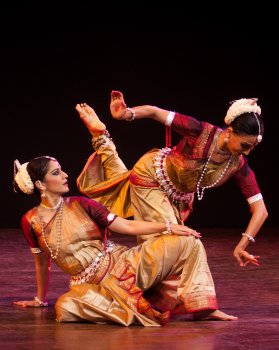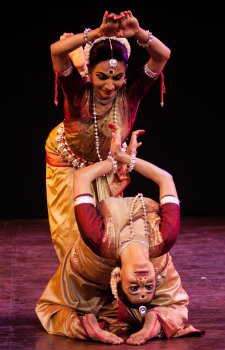
|   |

|   |
Samyoga: An ode to Love - Padma Jayaraj e-mail: padmajayaraj@gmail.com Photos courtesy: NCPA September 14, 2012 Nrityagram presented an Odissi dance recital at NCPA in Mumbai that inaugurated a week long residency program. The evening of August 25 saw a beautiful ode to love, which opened the gates of an ancient culture still alive in the temples of Puri and Konark. The sculptures of Konark have inspired the art forms of the land of Odisha, and today it is celebrated all over India.  Surupa Sen and Bijayani Satpathy, the leading artistes of Nrityagram, have worked together to perform like the confluence of two rivers and Samyoga is a beautiful creation perfect in rhythmic balance, synchronization of movements, grace and spirit – a symphony in itself. Samyoga opens with an Annamacharya composition “Narayana Namah” invoking Lord Vishnu. The gods of Puri in front of the lighted lamp are pleased with the ceremonial offerings. With lyrical lighting and flowing music, Surupa Sen enters to transform the dark stage into an ethereal land. Evocative of ancient myths, Lord Narayana alights on his vehicle, Garuda. The dancer portrays the endless bliss of a devotee in whirling movements, recalling sage Narada with his musical instrument, full of devotion for Lord Narayana. The ceremonial invocation is just a prelude to the enchanting Rathi Sringara, set to rag Desh. Both the dancers complement each other exploring the myriad dimensions of the abstract vocabulary of Odissi, competing with abstract music from a superb orchestra (Jatin Sahu – vocal and harmonium, Shibu Shanka Satpati – mardala, Parasuram Das - bamboo flute, Sanjeev Kunda – violin). The Pallavi paints the joy and thrill of young, frolicking love in idyllic romance without passions and pains, a love that is joy incarnate. The sinuous movements, captivating images, expressive faces, etch tabloids on flowing time. Blossoming lighting gives a magic touch to its enchantment. Dressed alike, the dancers portray the mirror image in a pose as a refrain, a marked feature throughout the recital. Narcissistic in dimension, it opens the interior of the human heart, the citadel where love is enthroned. From the abstract we move to the concrete in the third and the fourth items that depict the two sides of the coin – love. The lore of Radha and Krishna from Jayadeva’s Ashtapadi, celebrated by countless artists down the history of art, is the means to reveal the female and male approach to love, a strange chemistry that has baffled everyone. “Yahi Madhava Yahi Keshava” by Surupa Sen enacts Radha, the Kanditha nayika. Here she stands for the innate dignity of womanhood that has the strength to remain the forsaken. The female approach to love is presented as noble, demanding, straightforward – an all-consuming passion, when she asks Krishna to leave. She has the moral strength to close the door in deep pain and dignity embracing the tragic. 

Lighting lends depth to the poses: red lights cast dark shadows of Radha under her feet, speak of her flaming passion that dwarfs her Self. The blue light, with dark silhouettes of sculpturesque poses proliferate like the images of stone figurines on temple walls. And with music flowing from the bamboo flute, moonlight streams to spread the charm of the mystique. The persona of the forsaken woman evokes the frozen Ahalya, deceived by love in a former yuga. The music and lighting gives a poetic and allegoric depth to the dance that depicts the story in fleeting poses which showcases the transitory emotion – love. The fourth item “Priye Charusheele” performed by Bijayani Satpathy portrays Krishna coming back to Radha after the spell of separation. The performance points to the male path to love. Again, it is Krishna, the epitome of romance, for whom everything is a prank, for whom stealing glances is a mode of expression. He could go to any extent to placate Radha. The artiste’s facial expressions lend a touch of mockery. Krishna being Krishna, whether divine or human, has played upon the anguish and vulnerability of the very human Radha. Alas, what a predicament from emotional to philosophical angles. The grand finale rounds off the theme of Samyoga in vibhakt. A fresh interpretation of Ardhanareeshwara reveals the male-female principles, the two halves complementing each other in union, whence Creation springs. The two primal entities live in perfect harmony - at once distinct and yet separate, harmonious and blended. Each acknowledges and celebrates the other. In a kaleidoscopic display of the image of Shiva-Parvathi, the eternal couple, the dancers scintillate and freeze in sculpturesque poses. The mirror image becomes specific and meaningful in their poise. Rhythmic music forms the base of the thandava; violin and flute embellish the lasya. The wonderful piece flows like a dream. The Ardhanareeshwara sthothram that is sung in the background, attributed to Adi Shankara, is presented as a love song as well as a celebration of the duality of human spirit. The audience received the last item with thunderous applause. It lifted their spirit as they watched the drama within the dance. Lighting, like music, needs special mention. Lynne Fernandez has added another dimension to the dance piece. Whenever Krishna appears, the flute dominates with the blue shade of light, creating moonlit nights of incomparable beauty and serenity, against which the human angst is painted. What a perfect backdrop to the sagas of love. The dancers, leading lights of Nrityagram, with their two decades of experience in dancing, are masters of both the art and craft. Their agile bodies speak of the years of practice. And gracefully, age has not withered both their face and spirit. Padma Jayaraj is a freelance writer and a regular contributor to narthaki.com |